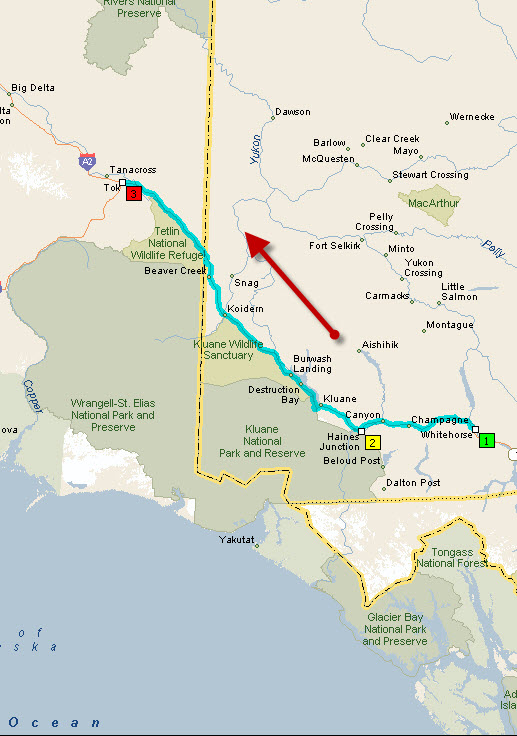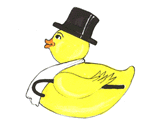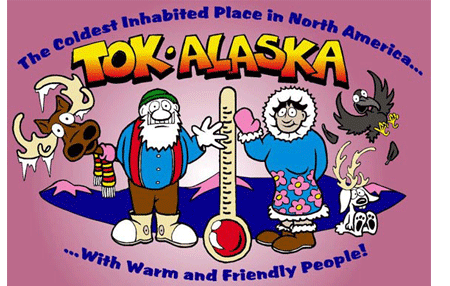NORTH TO ALASKA
EPISTLE TWO
May 30th: 2004

The drive to Tok Alaska would be a long day. The road was in
pretty good
condition from Whitehorse to Haines Junction so we made good
time. I was getting a little cocky (again ... you'd think I would
learn by now...) and was comparing the Alaska Highway, so far, to the
Trans Canada
in Northern Ontario with the comparison that the Alaska highway, for
the most part, makes the drive from Winterpeg, through Wawa to Ottawa,
look really bad. We turned north from Haines Jct. and things
altered greatly!
The road runs along the west side of the St. Elias mountains and on the
east side a plethora of beautiful lakes. The trees have changed
to mostly Aspen and black spruce which grow very slowly in the
ever-present
muskeg. To tell you the truth, the scenery is getting quite
repetitious. Black spruce only grow to be around 15 to 20 feet
high and are very thin and scraggly. It is not comparable to the
trees we were accustomed further south. The lakes, now they were
beautiful. The water is deep, deep blue and reflected the clouds
almost like a mirror. In fact, Kluane Lake...which is really
quite huge...if it had been located several degrees of latitude south,
would
have been surrounded by thousands of summer cabins nestled along its
shores. As it was ... nothing ... just beautiful lake; no sign of
human inhabitation at all. Pure paradise eh? Well, you have
to add to all that poetic loveliness the fact that the ice does not
retreat completely until early May and returns in mid September.
And, don't forget the mosquitoes!!!! All that muskeg around the
lake has two nasty side effects ... the production of serious mosquito
breeding areas and the cause
of a northern phenomenon ... creating really serious frost
heaves. We
stopped along side of one of those little gems for lunch. I'm not
sure if we were to have lunch or whether we were to be
lunch! But, upon seeing another tourist parked in the little lot,
and  fishing from the shore was enough to make us feel that a lunch
break was in order. We pulled in and got the dogs ready for one
of their "squeeze and squirt" sessions, and opened the door. The
sun was shinning nicely and the shore line was only about 50 yards
away. Off I go to see how the fisherman was doing. I walked
briskly to the little dock area and watched him cast several times out
into the lake. "Any luck", I ask?
fishing from the shore was enough to make us feel that a lunch
break was in order. We pulled in and got the dogs ready for one
of their "squeeze and squirt" sessions, and opened the door. The
sun was shinning nicely and the shore line was only about 50 yards
away. Off I go to see how the fisherman was doing. I walked
briskly to the little dock area and watched him cast several times out
into the lake. "Any luck", I ask?
"Not yet, but these lakes must be just crammed full of Northern
Pike. It is just a matter of time until I get a strike!"
Well, we are crafty people, and we did cover ourselves with bug spray,
but I began to notice that there were swarms of little insects swirling
around in the breeze. They had not noticed me yet, so I wasn't
worried too much. Just then a shout came from the fisherman ...
He had just cast out far into the lake, and his rod was now sticking
straight out with his line overly taunt.
"A strike, he proclaimed loudly!" In the past, I have not done
much fishing, but I can differentiate between a strike and a
snag. The poor bugger had snagged an underwater log and was
desperately trying to pull it to the surface. After about 2
minutes of this controlled chaos, his line had not moved. He was
yelling that it was the biggest strike he had ever had!!!
"Yeah", I thought, "not often you catch a 500 pound tree". He
suddenly yarded on his line which conveniently broke, and he started to
head quickly back to his rig. Why, I thought? Then I
noticed the swarm around his head. All the noise and
commotion must have attracted the "state bird" of Alaska, for he was
being eaten alive. They must have noticed me too, for they were
beginning to irritate! For those of you who think that seeing one
or two mosquitoes a summer represents an infestation, let me assure
you that it isn't! We had put bug spray on  exposed skin, but had
not sprayed our clothing. The little blighters can poke their
proboscis through several layers of clothing with absolutely no problem
whatsoever! I headed back to Harvey in a rush and arrived there
at the same time Elsie was returning with the dogs. By the look
in her eyes, I sure could see that she too had been exposed to the
little buggers. Slamming the door, we realized that lunch today
would be an indoor affair. But, not so for our intrepid
fisherman! He soon had replaced his lure and leader and was
heading
back to catch that elusive Pike. Good luck we thought, we don't
like fish all that much! His wife, we noticed, stayed inside and
read a magazine. What can you expect, we thought, he was from
Florida!
exposed skin, but had
not sprayed our clothing. The little blighters can poke their
proboscis through several layers of clothing with absolutely no problem
whatsoever! I headed back to Harvey in a rush and arrived there
at the same time Elsie was returning with the dogs. By the look
in her eyes, I sure could see that she too had been exposed to the
little buggers. Slamming the door, we realized that lunch today
would be an indoor affair. But, not so for our intrepid
fisherman! He soon had replaced his lure and leader and was
heading
back to catch that elusive Pike. Good luck we thought, we don't
like fish all that much! His wife, we noticed, stayed inside and
read a magazine. What can you expect, we thought, he was from
Florida!
Bug control is a very important issue here! When we went to
Africa 10 years ago, we were told to buy bug spray in the US. In
Canada, you can only get spray that contains 40% deet, which is the
active chemical that kills the bugs. In the US you can get
95% deet easily, and if you search around, apparently you can find
97%. By now, all our bug spray we had for Africa had past its
"best by date" so forgetting the deet levels we purchased Canadian 40%
stuff. Fortunately, by the time we left DogPatch heading north,
we remembered the strength levels, and we did find 95% deet
spray.
With this stuff, it is possible to go outside and survive. But,
as I said before, they can still penetrate clothing. The trick
is, like in life, "you got to keep moving otherwise you are a sitting
duck!"
Inside Harvey is another "war zone". When one of those flying
menaces has the temerity to enter Elsie's "sanctum" all hell breaks
loose. When we first started this RV experience, we were told by
George and Marsha Kristensen, experienced RVers, to purchase what on
first appearance looks like small badminton racquets, but in
actuality, are very efficient fly swatters. Instead of having cat
gut strings in the head, they have little metal wires that after you
push a button on the side of the handle to activate the batteries, it
becomes a killing machine. If you make the mistake of touching
the wires once activated, you sure don't want to make the same mistake
twice! Neither do the bugs! There is sufficient voltage
there to "fry their little a**es off"! Somehow, with one of these
in your
hands, you don't feel quite as vulnerable to nature. The sparks
they give off as they fry the intruder is strangely
satisfying. Elsie has it
down to a very fine art and not one of the little buggers survive long
once inside. "Outside is their domain, inside is mine"! she
screams as she takes deadly aim. Last year, we took only one
racquet with us, and it died in Newfoundland
just when the bugs were getting really bad. Nowhere could we find
a replacement. This year, Elsie
packed four of them ..."just in case"! She takes her bug free
domain very seriously!!!
Now, to the condition of the roads past Haines Jct. and onward to
Tok. From the air these roads must look good. There are
straight sections that go on for miles. The hills aren't too
promounced and where there is construction, it looks like they are
keeping the roads well graded. Now, as to experiencing them on
the ground ... it is another issue. Most Class A RVs have the
basic suspension; you know, shocks and springs. Well, they add
air bags to the mix so that on smooth roads and curves, the ride is
silky soft. Not so on the famous northern frost heaves
though. The speed limit is 100 kms and as you round a bend and
see the road stretch out for miles before you, you are tempted to put
the throttle down a little and actually reach 100 kms per hour.
Not a good idea!!!
Picture if you would, one of the old washing boards they used to have
to scrub clothes in the old days. As you look down the road with
the center line suffering the wear and tear of the winter sanding, all
looks great. As the speed increases, so does the
danger. With little or no warning,  the front of Harvey drops
sharply ... and then just as sharply it rises, The rise and fall
can be several inches ... no big deal ... to several feet ... big
deal. Put several of these ridges together, and Harvey goes from
the bottom of his air bag, signified by a gut renching thud, to the top
of the bag signified by the feeling that you are about to be
airborne. When this happens over and over and over again, driving
becomes a real challenge. It is supposed to be only a 6 hour
drive to Tok but when 40 to 50 kms per hour is all you can do safely,
the length of the day stretches out ..... Add to this the
ubiquitos road work sections .... and patience thins.
the front of Harvey drops
sharply ... and then just as sharply it rises, The rise and fall
can be several inches ... no big deal ... to several feet ... big
deal. Put several of these ridges together, and Harvey goes from
the bottom of his air bag, signified by a gut renching thud, to the top
of the bag signified by the feeling that you are about to be
airborne. When this happens over and over and over again, driving
becomes a real challenge. It is supposed to be only a 6 hour
drive to Tok but when 40 to 50 kms per hour is all you can do safely,
the length of the day stretches out ..... Add to this the
ubiquitos road work sections .... and patience thins.
I guess they really only have 3 months to do all the repairs on the
Alaska Highway. The Freeze comes early and leaves late. The
longest dirt section, about 20 miles, strectches along the side of
Kluane Lake.
Here, you are suicidal if you allow your speed to exceed 30kms.
The workers keep the dirt wet to keep down the dust but there are
always loose rocks.  People coming towards you pitch up debris
that seems to have you as the target, and Harvey himself keeps the
front of the Toad covered with rocks --- some the size of marbles.
The wet dirt, also thrown up on the Toad, soon makes it impossible to
ascertain the make of your tow car. Suffice it to say, it was a
very looooong day to Tok. The worse part of it seemed to be that
we would have to retrace this same route when we return south.
Not a pretty thought .... But get to Tok we did!
People coming towards you pitch up debris
that seems to have you as the target, and Harvey himself keeps the
front of the Toad covered with rocks --- some the size of marbles.
The wet dirt, also thrown up on the Toad, soon makes it impossible to
ascertain the make of your tow car. Suffice it to say, it was a
very looooong day to Tok. The worse part of it seemed to be that
we would have to retrace this same route when we return south.
Not a pretty thought .... But get to Tok we did!

We arrived dead tired and with little food in the larder that would
lend itself to a quick dinner preparation. In fact, we did not
bother to wash Harvey and the Toad and just pulled into the site with
the Toad still attached. One night here would be sufficient as
Tok itself is only a series of small stores and gas stations. It
is the first town just inside the Border. The Border, bu the way,
was no problem. Actually, the Border Guard was friendly and even
welcomed us to Alaska.
I should mention here where the name Tok came from and just how to
pronounce it. It is not an Idian name as I first assumed.
According to the tourist guides, before the last world war, Tok was
called Tokyo and like Berlin Ontario in the first war, now Kitchener,
and the Royal Family once Hanover and now Windsor, Tokyo decided that
it would be clever to change their name to a more politically correct
one. So, rather than totally change the name, they just dropped
the "yo". So the way to pronoucnce it is just use the first
syllable of Tokyo. Interesting eh??